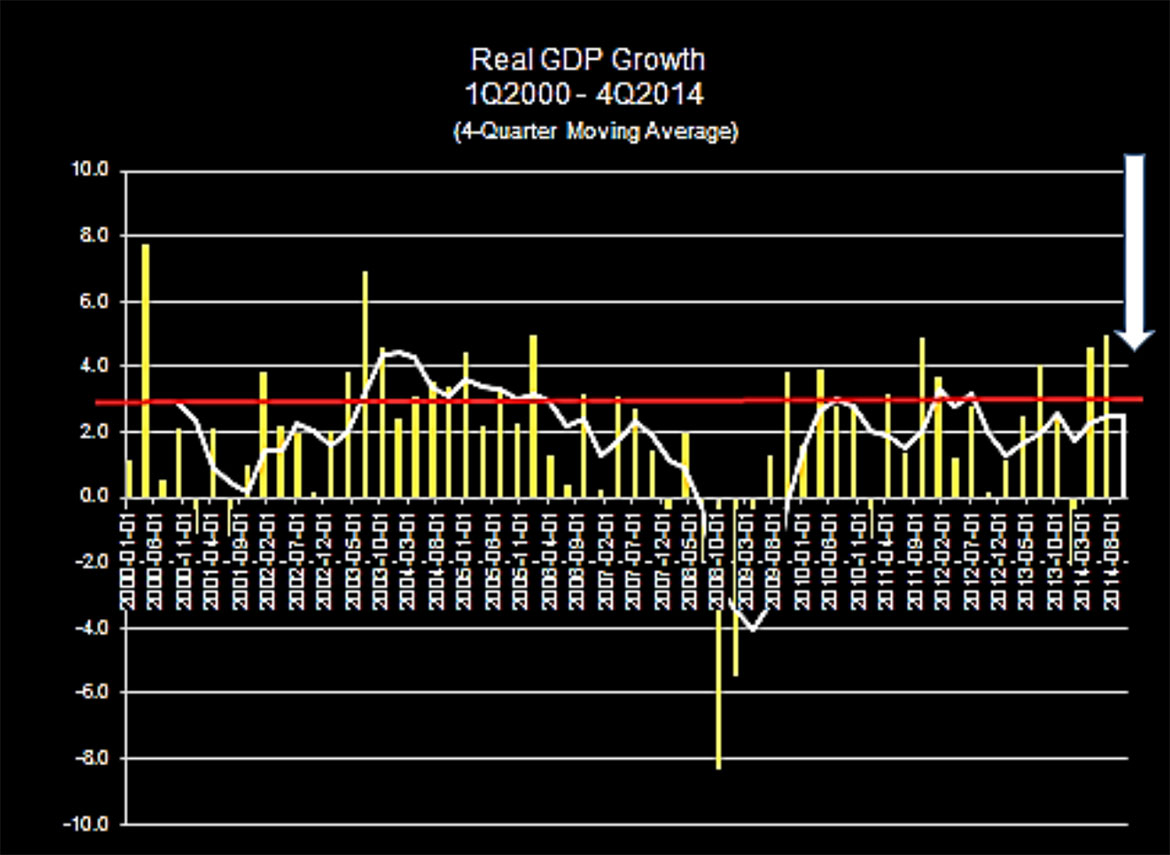- | Government Spending Government Spending
- | Policy Briefs Policy Briefs
- |
The Economic Situation, March 2015
Has the US economy kicked off third quarter’s running cleats and slipped on bedroom shoes with very soft soles? The running pace has changed abruptly. As the accompanying chart tells us, the second estimate for growth in the fourth quarter of 2014 fell to 2.2 percent from the third quarter’s hair-raising 5.0 percent. Is this the economic engine that is pulling the world economy?
The US Locomotive Economy
Has the US economy kicked off third quarter’s running cleats and slipped on bedroom shoes with very soft soles? The running pace has changed abruptly. As the accompanying chart tells us, the second estimate for growth in the fourth quarter of 2014 fell to 2.2 percent from the third quarter’s hair-raising 5.0 percent. Is this the economic engine that is pulling the world economy? Yes, it’s the best engine the system has. So why the sudden shift to second gear? Weakness in the rest of the world is the major part of the story. Still seeking higher ground, Europe is slowly backing away from the edge of recession. China is running in third gear with its growth hitting 7 percent instead of its “normal” 10 percent. Canada and Mexico are moving along at 2.5 percent growth. And Japan’s economy has launched again but is just beginning to sail. The world economy is a mixed bag but still a decidedly weak one.
Meanwhile, with the dollar getting good as gold, while others cut interest rates in the hope of stimulating growth, US exports are falling and imports have surged.The chart’s white four-quarter moving average shows real GDP growth is averaging about 2.6 percent for the year. The gap between current growth and the 3.14 percent long-term average may look like a permanent feature of the data landscape, but most forecasters are betting the gap will be closed as 2015 progresses. As always, there are some special considerations. This time it is energy, and this time the net effect is positive.
More on the Energy Story
The effects of the better than 50 percent decline in crude prices since June 2014 are now working their way through the economy. US commentators cheered the explosive growth of shale oil production that triggered the price decline, and they should have. As will be shown later, it was growth in the shale oil states that propelled the US economy as it sailed out of the recession. But folks on the other side of the pond—OPEC and its leader, Saudi Arabia—somehow felt differently about the matter. Let’s face it, when prices fall, it matters whether you are a buyer or seller, a producer or a consumer, and folks who have dominated a product market for decades just don’t go quietly into the night. On balance, of course, the United States is a consumer.
Lower energy prices are a boon to the economy, maybe adding as much as 0.50 percentage points to GDP growth.The decline in crude oil prices came when the Saudis targeted the United States and Asia with a price cut, raised their price to Europe, and opened up the valves for more oil production. When the price plummeted from $100 a barrel to $45, the Saudis responded with a smile. They are the world low-cost producer, and have lots of loot in their sovereign fund for weathering a long price war. Holding market share seems to be their current strategy.
While consumers overall can enjoy large savings in transportation cost, something on the order of $750 a year for the average family, just where they live and work puts a different spin on that, too.


